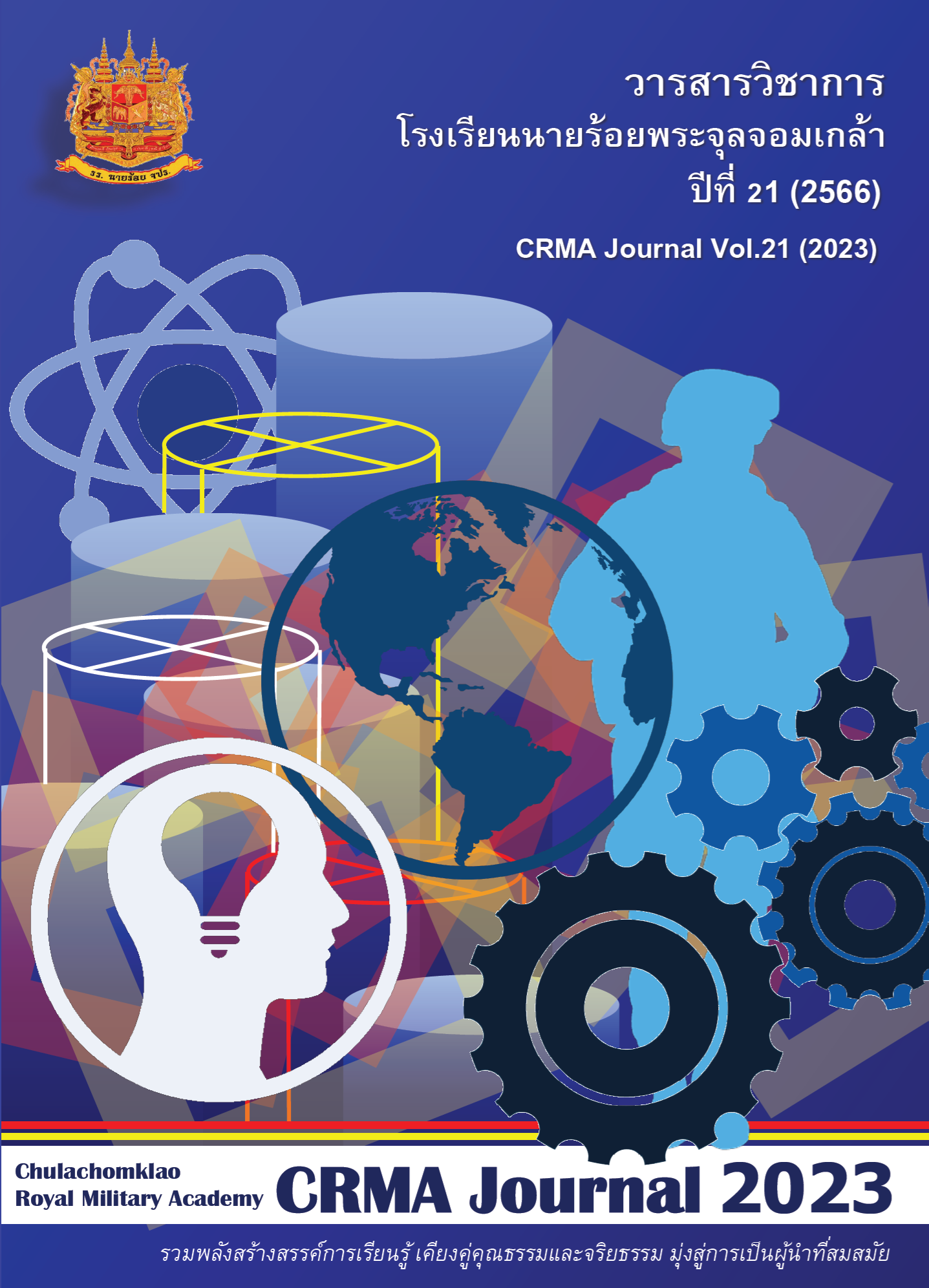การศึกษาเปรียบเทียบค่ากำลังของวัตถุระเบิดแรงสูงจากการคำนวณทางเทอร์โมเคมีอย่างง่ายและค่าจากการทดลอง
Main Article Content
บทคัดย่อ
งานวิจัยนี้เป็นการศึกษาค่ากำลังของวัตถุระเบิดแรงสูงที่มีการใช้งานทางทหารและทางพลเรือนจำนวน 18 ชนิด จากการคำนวณโดยใช้หลักการทางเทอร์โมเคมีอย่างง่ายเปรียบเทียบกับค่ากำลังของวัตถุระเบิดที่ได้จากการทดลองโดยใช้วิธี Trauzl Lead Block Test พบว่าค่ากำลังของวัตถุระเบิดทั้ง 18 ชนิด ที่คำนวณโดยใช้หลักการทางเทอร์โมเคมีอย่างง่ายมีค่าใกล้เคียงกับค่ากำลังของวัตถุระเบิดที่หาโดยวิธี Trauzl Lead Block Test นอกจากนี้จากการศึกษาความสัมพันธ์ระหว่างค่าสมดุลออกซิเจนกับค่ากำลังของวัตถุระเบิดที่หาได้ทั้งจากการคำนวณโดยใช้หลักการทางเทอร์โมเคมีอย่างง่ายและจากการทดลองโดยวิธี Trauzl Lead Block Test พบว่าวัตถุระเบิดที่มีค่าสมดุลออกซิเจนเข้าใกล้ศูนย์จะเป็นวัตถุระเบิดที่มีค่ากำลังของวัตถุระเบิดมากกว่าวัตถุระเบิดที่มีค่าสมดุลออกซิเจนเป็นค่าบวกหรือค่าติดลบมาก ๆ ซึ่งความสัมพันธ์ดังกล่าวสามารถนำไปใช้อธิบายการออกแบบวัตถุระเบิดผสมชนิด Ammonium Nitrate Fuel Oil (ANFO) ที่นิยมใช้อัตราส่วนผสมระหว่างแอมโมเนียมไนเตรท 94% ต่อน้ำมันเชื้อเพลิง 6% ได้เป็นอย่างดี
Article Details

อนุญาตภายใต้เงื่อนไข Creative Commons Attribution-NonCommercial-NoDerivatives 4.0 International License.
ผลงานที่ได้รับการตีพิมพ์ ถือเป็นลิขสิทธิ์ของวารสารฯ
เอกสารอ้างอิง
A. Bailey and S. G. Murray, “Explosives, Propellants and Pyrotechnics”, Brassey’s (UK) Ltd, pp. 55-57, 1989.
J. Akhavan, “The Chemistry of Explosives”, 3rd ed. The Royal Society of Chemistry, pp. 74-102, 2004.
J.P. Agrawal, “High Energy Materials”, John Wiley & Sons, pp. 17-33, 2010.
Department of the Army Technical Manual, “TM9-1300-214 Military Explosives”, Washington D.C.: US Army, pp.3-1-3-4, 1984.
W.C. Lothrop, and G.R. Handrick, “The relationship between performance and constitution of pure organic explosive compounds”, Chemical Reviews, vol. 44, no. 3, pp. 419-445, doi: 10.1021/cr60139a001, 1949.
M.H. Keshavarz, M. Ghorbanifaraz, H. Rahimi, and M. Rahmani, “Simple pathway to predict the power of high energy materials”, Propellants, Explosives, Pyrotechnics, vol. 36, no. 5, pp. 424-429, doi: 10.1002/prep.201000083, 2011.
R. Meyer, J. Kohler, and A. Homburg, “Explosives”, 6th ed. John Wiley & Sons, 2007.
A.R. Martin, and H. J. Yallop, “The correlation of explosive power with molecular structure”, Journal of Applied Chemistry, vol. 9, no. 6, pp. 310-315, doi: 10.1002/jctb.5010090604, 2007.
M.H. Keshavarz, and F. Seif, “Improved approach to predict the power of energetic Materials”, Propellants, Explosives, Pyrotechnics, vol. 38, no. 5, pp. 709-714, doi: 10.1002/prep.201200165, 2013.
W. P. Lai, P. Lian, Y. Z. Liu, T. Yu, W. L. Zhu, Z. X. Ge, and J. Lv, “Design and theoretical study of 15 novel high energy density compounds”, Journal of Molecular Modeling, vol. 20, no. 11, doi: 10.1007/s00894-014-2479-y, 2014.
P. Lian, C. Kang, Y. X. Zhang, S. Chen, and W. P. Lai, “Theoretical study on new high energetic density compounds with high power and specific impulse”, FirePhysChem, vol. 1, no. 2, pp.103-108, doi: 10.1016/j. fpc.2021.04.006, 2021.


